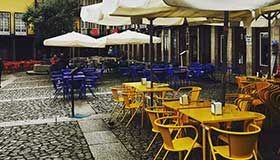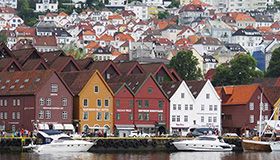In mid-afternoon on October 9, 37 Badgers and friends arrived at the elegant Palazzo San Lorenzo Hotel (a refurbished, 17th-century hospital) in the picturesque, medieval hill town of Colle di Val d’Elsa, and thus began our weeklong adventure in what is perhaps the best known of the 20 Italian regions: Tuscany. Over the space of a week, we explored the wonders of Siena and Florence on full-day trips, while dedicating shorter periods of time to the lovely towns of San Gimignano, Massa Marittima, Casole d’Elsa, and Castellina in Chianti (where we enjoyed both a cooking demonstration and its immediate fruits as lunch).
One morning we visited a major processing plant in the area for pecorino (sheep cheese) and ricotta and sampled the delicious products accompanied by several of the region’s fine wines. And, given that we were in the Chianti area (or “Chiantishire,” as the many expatriate British residents living in the area like to call it), we had a delightful tour of the Monsanto vineyard with a variety of snacks to accompany our tasting of several of its fine vintages. Another fascinating place that we visited was the crystal factory ColleVilca, where, true to the 800-year history of production in the area, we saw fine crystal being made by hand and marveled over the finely crafted pieces on display.
Much of what little we know about the mysterious Etruscan people, who inhabited the area several centuries B.C.E., comes from a variety of artifacts documenting their lives and particularly their attitudes concerning the afterlife (funerary urns, gold work, etc.). These we examined in the small but well-endowed museum in Casole. Local guides provided expert commentary on the history and legends of the area, and one particularly enchanting site was the abandoned, 12th-century Cistercian Abbey of San Galgano and the nearby chapel of Montesiepi containing the sword, which, according to legend, Galgano fixed in the rock as a cross following a vision of God and the apostles.
In Siena we had the great privilege of seeing all of the intaglio works that constitute the floor of the Duomo; these are completely uncovered for one month each year for special viewing. In Florence we maneuvered through the hordes of tourists who were determined either to “shop until they dropped” or to see all the Renaissance art they could in a day’s time. Many in our group had reserved specific entry times to the Accademia to see Michelangelo’s David or to the Uffizi Gallery to gaze upon the masterpieces of Giotto, Botticelli and other painters.
Early-evening lectures in the hotel focused on the rich history of Tuscany and Florence, Renaissance art and architecture, medieval pilgrimages and life in contemporary Italy. This latter presentation was complemented by an open-ended discussion on a variety of topics with some of the local citizens of Colle, who responded to questions about their life, work, views and activities.
And the food! The bountiful buffet breakfast gave us sustenance for the day’s travels, and although the other meals were generally provided either at the hotel or in restaurants during our day trips, we were sometimes free to seek out restaurants on our own, as we did in Siena and Florence. One memorable occasion was our farewell reception and dinner. They were held at the 12th-century Molino il Moro (a medieval mill for both wheat and paper in Colle Bassa, the more modern town on the plain), where the dulcet strains of “Varsity” and much good cheer echoed. The week in Tuscany gave us an appreciation of the many wonders of Italy, to which we would love to return.







